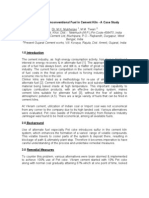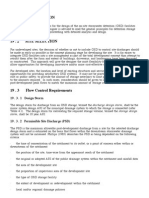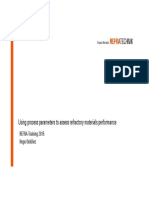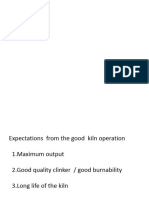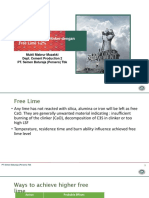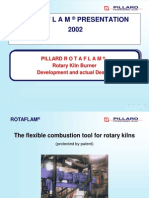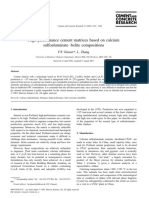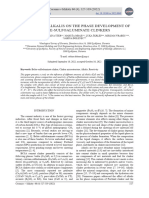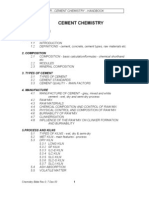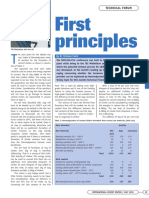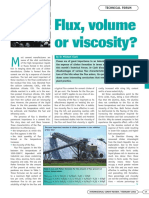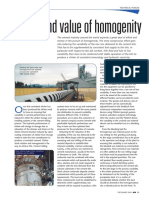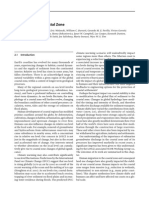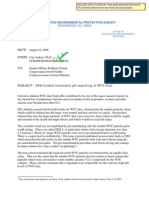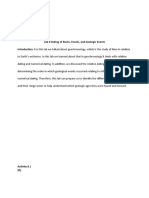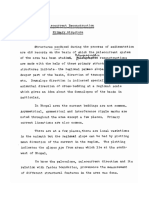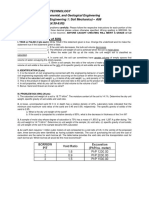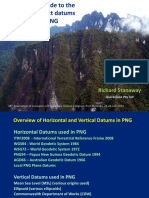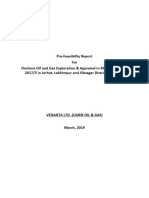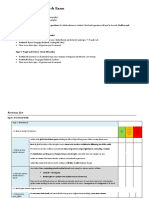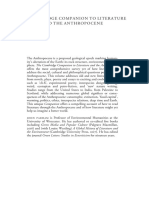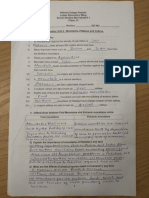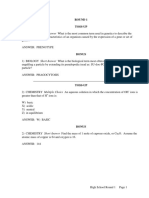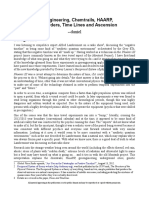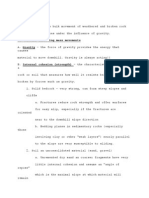K2o & P2o5
K2o & P2o5
Uploaded by
Elwathig BakhietCopyright:
Available Formats
K2o & P2o5
K2o & P2o5
Uploaded by
Elwathig BakhietOriginal Description:
Original Title
Copyright
Available Formats
Share this document
Did you find this document useful?
Is this content inappropriate?
Copyright:
Available Formats
K2o & P2o5
K2o & P2o5
Uploaded by
Elwathig BakhietCopyright:
Available Formats
CemNet Training - Course CKPC01
Module 2.6
Cement Kiln
Process Chemistry
Module 2. Cement clinker quality and composition.
2.6 K2O barrier, SO3, P2O5 decomposition.
Cement Kiln Chemistry
2.6 K2O Barrier
In the preceding session of the course we saw that the clinker
mineral composition can deviate from that calculated according to
Bogue due to the cooling rate of the clinker.
We also introduced the possibility that the presence of minor
components which prevent combination of the clinker minerals,
or decompose the clinker minerals after they have formed can
affect the potential mineral composition.
In particular three species which are present in cement clinker
with some regularity, K2O, SO3 and P2O5, were suggested to
have these effects.
Cement Kiln Chemistry
2.6 K2O Barrier
The alkali metals, K2O and Na2O, are always present in cement
clinker, usually derived from the clay components in the raw mix.
We learned in Module 1 that K2O will preferentially combine
with chloride in the hot meal, and that any excess will then
preferentially combine with sulphate to form K2SO4.
In clinker there will be very little chloride or KCl, due to the
volatility of chlorides at the temperatures in the burning zone of
a cement kiln, K2O in clinker will therefore be preferentially
combined as sulphate, K2SO4.
K2O levels are normally (~3x) higher than Na2O levels in
clinker and provided sufficient sulphate is available, the alkalis
will be combined in the double salt K3Na(SO4)2. in clinker.
This document is for the sole use of students enrolled on course CKPC01 and cannot be reprinted, reproduced or distributed without prior written consent from Tradeship Publications Ltd
http://Training.CemNet.com
CemNet Training - Course CKPC01
Cement Kiln Chemistry
Module 2.6
2.6 K2O Barrier
The alkali metals, K2O and Na2O, are always present in cement
clinker, usually derived from the clay components in the raw mix.
Complications arise when there is insufficient sulphate available
to fully combine with the alkalis, K2O and Na2O in
this case the alkalis enter the clinker minerals.
Both alkalis can be taken into solid solution in the main clinker
minerals, C3S, C2S, C3A and C4AF although, as we
saw in session 1.6, they are preferentially taken into solid
solution in the C2S rather than the C3S and this explains their
inhibiting effects on C3S formation.
Solid solution:
K2O
Na2O
C3S
0.1~0.3%
0.1~0.3%
C2S
0.2~1.0%
0.3~1.0%
Cement Kiln Chemistry
2.6 K2O Barrier
The alkali metals, K2O and Na2O, are always present in cement
clinker, usually derived from the clay components in the raw mix.
Complications arise when there is insufficient sulphate available
to fully combine with the alkalis, K2O and Na2O in
this case the alkalis enter the clinker minerals.
Both alkalis can be taken into solid solution in the main clinker
minerals, C3S, C2S, C3A and C4AF both alkalis are
taken into solid solution in the C3A mineral and to a much
lesser extent the C4AF.
Solid solution:
K2O
Na2O
C3A
0.4~1.1%
0.3~1.7%
C4AF
0.0~0.1%
0.0~0.5%
Cement Kiln Chemistry
2.6 K2O Barrier
The alkali metals, K2O and Na2O, are always present in cement
clinker, usually derived from the clay components in the raw mix.
Complications arise when there is insufficient sulphate available
to fully combine with the alkalis, K2O and Na2O in
this case the alkalis enter the clinker minerals.
Alkalis in excess of sulphate and that that can be taken into
solid solution in the main clinker minerals, C3S, C2S, C3A and
C4AF form modified clinker minerals, NaC8A3 and KC23S12.
Essentially one unit of Na2O is substituting for 1 unit of CaO in
and one unit of K2O is
every third unit of C3A
substituting for CaO in every 12th unit of C2S.
This document is for the sole use of students enrolled on course CKPC01 and cannot be reprinted, reproduced or distributed without prior written consent from Tradeship Publications Ltd
http://Training.CemNet.com
CemNet Training - Course CKPC01
Cement Kiln Chemistry
Module 2.6
2.6 K2O Barrier
The alkali metals, K2O and Na2O, are always present in cement
clinker, usually derived from the clay components in the raw mix.
Complications arise when there is insufficient sulphate available
to fully combine with the alkalis, K2O and Na2O in
this case the alkalis enter the clinker minerals.
Alkalis in excess of sulphate and that that can be taken into
solid solution in the main clinker minerals, C3S, C2S, C3A and
C4AF form modified clinker minerals, NaC8A3 and KC23S12.
It has been reported that NaC8A3 and KC23S12 have greater
and
hydraulic reactivity that C3A and C2S
therefore that setting time is shortened and strength
but other researchers report their
development promoted.
hydraulic activity as essentially the same and suggest simply
adding NaC8A3 to C3A and KC23S12 to C2S.
Cement Kiln Chemistry
2.6 K2O Barrier
The alkali metals, K2O and Na2O, are always present in cement
clinker, usually derived from the clay components in the raw mix.
Complications arise when there is insufficient sulphate available
to fully combine with the alkalis, K2O and Na2O in
this case the alkalis enter the clinker minerals.
Alkalis in excess of sulphate and that that can be taken into
solid solution in the main clinker minerals, C3S, C2S, C3A and
C4AF form modified clinker minerals, NaC8A3 and KC23S12.
Clearly formation of new clinker minerals NaC8A3 and KC23S12
C3A
is not taken into consideration in the Bogue calculation
and C2S will be reduced by formation of these new
but if their hydraulic behaviour is
minerals.
comparable and NaC8A3 is simply added to C3A and
KC23S12 to C2S then this is perhaps not important.
Cement Kiln Chemistry
2.6 K2O Barrier
The alkali metals, K2O and Na2O, are always present in cement
clinker, usually derived from the clay components in the raw mix.
Complications arise when there is insufficient sulphate available
to fully combine with the alkalis, K2O and Na2O in
this case the alkalis enter the clinker minerals.
The main problem is that the mineral KC23S12 is not available
for combination with CaO in the final sintering reaction to form
C3S.
When K2O is substantially in excess of sulphate then a
significant proportion of the potential C2S in clinker can be
blocked from forming C3S in this way
the silica
which is tied up in KC23S12 is unavailable to combine with
free CaO and the remainder of the clinker is significantly
over-limed, possibly resulting in high free lime clinker.
This document is for the sole use of students enrolled on course CKPC01 and cannot be reprinted, reproduced or distributed without prior written consent from Tradeship Publications Ltd
http://Training.CemNet.com
CemNet Training - Course CKPC01
Cement Kiln Chemistry
Module 2.6
2.6 K2O Barrier
This effect can be illustrated by an example from a cement factory
where the K2O content of clinker is substantially in excess of the
SO3.
The excess K2O in clinker is given by the formula:
% Excess K2O = %K2O - %SO3 * 80/94
If the excess K2O is then presumed to combine as KC23S12 then
the content of this mineral which will be present is given by:
% KC23S12 = % Excess K2O * 2102/94
A very large factor due to only one unit of K2O being present in
the high molecular weight KC23S12.
Cement Kiln Chemistry
2.6 K2O Barrier
This effect can be illustrated by an example from a cement factory
where the K2O content of clinker is substantially in excess of the
SO3.
SiO2 combined in the mineral KC23S12 is not available to
combine with further free CaO and form C3S.
% Available SiO2 = % SiO2 - %Excess K2O * 720/94
% Residual CaO = % CaO - %Excess K2O * 1288/94
By this methodology the effective lime saturation of the
clinker was lifted by 5.5%.
Cement Kiln Chemistry
2.6 K2O Barrier
This effect can be illustrated by an example from a cement factory
where the K2O content of clinker is substantially in excess of the
SO3.
Resulting in significant periods when the clinker was
uncombinable due to real LSF well above 100%.
Kiln 2 clinke r LSF correcte d for combination of K2O in KC23S12
1.15
1.1
Corrected LSF
Conventional LSF
0.95
0.9
Date
27
30
18
24
15
12
21
30
21
24
27
18
15
12
25
31
22
28
16
19
10
May
13
0.85
Lime Saturation
1.05
July
This document is for the sole use of students enrolled on course CKPC01 and cannot be reprinted, reproduced or distributed without prior written consent from Tradeship Publications Ltd
http://Training.CemNet.com
CemNet Training - Course CKPC01
Cement Kiln Chemistry
Module 2.6
2.6 K2O Barrier
This effect can be illustrated by an example from a cement factory
where the K2O content of clinker is substantially in excess of the
SO3.
The excess K2O in clinker is given by the formula:
% Excess K2O = %K2O - %SO3 * 80/94
If the excess K2O is then presumed to combine as KC23S12 then
the content of this mineral which will be present is given by:
% KC23S12 = % Excess K2O * 2102/94
This methodology presumes all excess K2O will form KC23S12
and ignores solid solution .however it provides a real
example of the problems KC23S12 formation can cause..
.this kiln did suffer long periods with excessively high
free lime content in the clinker produced.
Cement Kiln Chemistry
2.6 P2O5 Decomposition
Some limestones used for cement manufacture contain
.this has certainly been reported in Uganda
phosphates..
and other central African limestones.
The effects of phosphates
on cement kiln performance
and clinker composition
have become topical in
Europe with the widespread
burning of meat and
bonemeal following the
BSE crisis.
Bonemeal injection lance.
Cement Kiln Chemistry
2.6 P2O5 Decomposition
Some limestones used for cement manufacture contain
.this has certainly been reported in Uganda
phosphates..
and other central African limestones.
The effects of phosphates
on cement kiln performance
and clinker composition
have become topical in
Europe with the widespread
burning of meat and
bonemeal following the
BSE crisis.
Bones are formed from calcium phosphate.
This document is for the sole use of students enrolled on course CKPC01 and cannot be reprinted, reproduced or distributed without prior written consent from Tradeship Publications Ltd
http://Training.CemNet.com
CemNet Training - Course CKPC01
Cement Kiln Chemistry
Module 2.6
2.6 P2O5 Decomposition
Some limestones used for cement manufacture contain
.this has certainly been reported in Uganda
phosphates..
and other central African limestones.
C3S can take up to 0.5% P2O5 into solid solution
with no loss of hydraulic properties.
Beyond that level there is progressive
decomposition of C3S in favour of a solid solution
of C2S and tricalcium phosphate, C3P.
If the C3P content rises beyond ~5% then C3S is
no longer a stable phase and completely breaks
down to C2S, C3P and CaO.
Portland cement clinker must contain C3S and high free
CaO content is also unacceptable.
Cement Kiln Chemistry
2.6 P2O5 Decomposition
Some limestones used for cement manufacture contain
.this has certainly been reported in Uganda
phosphates..
and other central African limestones.
C3S can take up to 0.5% P2O5 into solid solution
with no loss of hydraulic properties.
It is reported that adequate clinker can be
produced with P2O5 content up to 2~2.5%.....
..however, breakdown of C3S into C2S and
C3P has to be accepted...
..C3S will
be lower than calculated by Bogue and C2S will be
higher.
As the C3P content rises the , and C2S are
progressively stabilised.
Cement Kiln Chemistry
2.6 P2O5 Decomposition
Some limestones used for cement manufacture contain
.this has certainly been reported in Uganda
phosphates..
and other central African limestones.
C3S can take up to 0.5% P2O5 into solid solution
with no loss of hydraulic properties.
As the C3P content rises the , and
polymorphs of C2S are successively stabilised.
The polymorphic forms of the clinker minerals
will be discussed in the next session of the course,
however -C2S is the only form with appreciable
hydraulic properties ..avoiding the
transition to and -C2S, with attendant loss of
C2S hydraulic reactivity, are therefore further
reasons to limit the P2O5 content of clinker.
This document is for the sole use of students enrolled on course CKPC01 and cannot be reprinted, reproduced or distributed without prior written consent from Tradeship Publications Ltd
http://Training.CemNet.com
CemNet Training - Course CKPC01
Cement Kiln Chemistry
Module 2.6
2.6 P2O5 Decomposition
Some limestones used for cement manufacture contain
.this has certainly been reported in Uganda
phosphates..
and other central African limestones.
These adverse affects of P2O5 are somewhat offset
if fluorides are present, as can be the case with
phosphate bearing limestones.
Fluorapatite, C10P3.CaF2, then enters solid solution
in the C3S allowing a higher proportion of P2O5 to
be present before the progressive decomposition
of C3S to C2S and C3P sets in ..chloroapatite,
C10P3.CaCl2 can also increase tolerance of P2O5
in clinker..
..and has the added advantage of
binding chloride in C3S and reducing the cycles of
chloride that build up in a cement kiln.
Cement Kiln Chemistry
2.6 SO3 Decomposition
We have already discussed the effects of excess SO3 over alkalis in
session 1.9.. .this balance between alkalis and sulphates is a
topic we will keep returning to.
One of the potential effects of excess sulphates is similar to the
affect of P2O5 on clinker composition.
We saw in session 1.6 that SO3 preferentially enters into solid
solution in the C2S and for this reason is an inhibitor of C3S
formation. ..this solid solution of SO3 in C2S
stabilises the -C2S polymorph and makes combination with
CaO and conversion into C3S more difficult..the
breakdown of C3S into -C2S and CaO below 1250C is also
accelerated..
..low C3S content and high C2S
and free CaO content in clinker can be the result.
Cement Kiln Chemistry
2.6 SO3 Decomposition
We have already discussed the effects of excess SO3 over alkalis in
session 1.9.. .this balance between alkalis and sulphates is a
topic we will keep returning to.
One of the potential effects of excess sulphates is similar to the
affect of P2O5 on clinker composition.
We saw in session 1.6 that SO3 preferentially enters into solid
solution in the C2S and for this reason is an inhibitor of C3S
formation. ..this solid solution of SO3 in C2S
stabilises the -C2S polymorph and makes combination with
CaO and conversion into C3S more difficult.
Solid solution of minor components in the clinker minerals
and polymorphic form have been recurrent themes
..those will be
throughout this session..
the topic of the next session of the course
This document is for the sole use of students enrolled on course CKPC01 and cannot be reprinted, reproduced or distributed without prior written consent from Tradeship Publications Ltd
http://Training.CemNet.com
CemNet Training - Course CKPC01
Module 2.6
Cement Kiln
Process Chemistry
Module 2. Cement clinker quality and composition.
2.6 K2O barrier, SO3, P2O5 decomposition.
This document is for the sole use of students enrolled on course CKPC01 and cannot be reprinted, reproduced or distributed without prior written consent from Tradeship Publications Ltd
http://Training.CemNet.com
You might also like
- Use of Pet CokeDocument10 pagesUse of Pet CokeNilesh Oswal100% (1)
- Onsite DetentionDocument30 pagesOnsite DetentionWan RidsNo ratings yet
- Module 2 CSAF SystemDocument16 pagesModule 2 CSAF SystemElwathig BakhietNo ratings yet
- Bogue DeviationDocument8 pagesBogue DeviationElwathig BakhietNo ratings yet
- Cement Kiln Process Chemistry: Cemnet Training - Course Ckpc01Document10 pagesCement Kiln Process Chemistry: Cemnet Training - Course Ckpc01Elwathig BakhietNo ratings yet
- Textbook 3 Cementproduction v31Document8 pagesTextbook 3 Cementproduction v31Mohammad Awais NazirNo ratings yet
- RedoxDocument7 pagesRedoxElwathig BakhietNo ratings yet
- Cement Kiln Process Chemistry: Cemnet Training - Course Ckpc01 Module 3.3 - ExerciseDocument1 pageCement Kiln Process Chemistry: Cemnet Training - Course Ckpc01 Module 3.3 - ExerciseElwathig BakhietNo ratings yet
- QDocument33 pagesQसागर फुकटNo ratings yet
- What Is White Portland CementDocument3 pagesWhat Is White Portland CementOliver Raymundo100% (1)
- Book 6 Cement KilnsDocument24 pagesBook 6 Cement KilnsPrabakaran BaskaranNo ratings yet
- Nox Impacts On Environment and Human HealthDocument5 pagesNox Impacts On Environment and Human HealthnaikNo ratings yet
- Mineralisation PDFDocument11 pagesMineralisation PDFElwathig BakhietNo ratings yet
- Combustion CalculationesDocument3 pagesCombustion CalculationesSatish KumarNo ratings yet
- Chap 4 Cement TechnologyDocument52 pagesChap 4 Cement TechnologyMina1212No ratings yet
- Bybass Data SheetDocument5 pagesBybass Data SheetSatish KumarNo ratings yet
- CO Sources PDFDocument11 pagesCO Sources PDFElwathig BakhietNo ratings yet
- Process Parameters - Ordonez 2015Document126 pagesProcess Parameters - Ordonez 2015vũ minh tâm100% (2)
- Alternative Fuels For The Cement Industry PDFDocument6 pagesAlternative Fuels For The Cement Industry PDFPopovac NetNo ratings yet
- Mod 4Document58 pagesMod 4mkpqNo ratings yet
- Influence of Raw Materials Characteristics On PyroprocessingDocument19 pagesInfluence of Raw Materials Characteristics On Pyroprocessingamaralinga chariNo ratings yet
- Methods, Processes, and Equipment Involved in Manufacturing CementDocument15 pagesMethods, Processes, and Equipment Involved in Manufacturing CementDarelle David MalacaNo ratings yet
- Typical Raw Minerals 202.1Document2 pagesTypical Raw Minerals 202.1Mohammed AbdoNo ratings yet
- 4 - Pilot Scale Manufacture of LC3-Indian ExperienceDocument7 pages4 - Pilot Scale Manufacture of LC3-Indian ExperienceSakthivel ThangavelNo ratings yet
- D3P1 - Raw Materials Management PDFDocument11 pagesD3P1 - Raw Materials Management PDFDilnesa EjiguNo ratings yet
- Influence of Clinker So 3 On The Cement CharacteristicsDocument9 pagesInfluence of Clinker So 3 On The Cement CharacteristicsShakti Singh100% (1)
- Mod 5Document49 pagesMod 5mkpqNo ratings yet
- BasicCementChem - CIL2Document30 pagesBasicCementChem - CIL2D'izmi D'barcaNo ratings yet
- VDZ ActivityReport07 09Document140 pagesVDZ ActivityReport07 09jorge_acosta_112100% (1)
- ATEC Preheater Datasheet EnglDocument6 pagesATEC Preheater Datasheet EnglSatish KumarNo ratings yet
- VDZ-Onlinecourse 7 3 enDocument20 pagesVDZ-Onlinecourse 7 3 enAnonymous iI88LtNo ratings yet
- Reasons For Melt FormationDocument7 pagesReasons For Melt FormationJunaid MazharNo ratings yet
- Low Nox Calciner - BrochureDocument8 pagesLow Nox Calciner - BrochureMuhammadNo ratings yet
- Dinesh Agrawal: Dry-ProcessDocument19 pagesDinesh Agrawal: Dry-ProcessSantanu PachhalNo ratings yet
- Refrateck SolutionsDocument8 pagesRefrateck SolutionsMagesh Kumar0% (1)
- Combustion Cement Kiln Exercise2.3.2Document2 pagesCombustion Cement Kiln Exercise2.3.2Mohammed AbdoNo ratings yet
- Coating RingsDocument8 pagesCoating RingsIrshad HussainNo ratings yet
- A TEC Presentation, About A TECDocument38 pagesA TEC Presentation, About A TECFran JimenezNo ratings yet
- Cooling Cement Clinker Exercise2.3.4Document2 pagesCooling Cement Clinker Exercise2.3.4Mohammed AbdoNo ratings yet
- 0 Basics Facts About ClinkerDocument1 page0 Basics Facts About ClinkerAhmed Younis100% (1)
- Petroleum Coke Utilization For Cement Kiln FiringDocument8 pagesPetroleum Coke Utilization For Cement Kiln FiringSyeed SofieNo ratings yet
- Tips On Kiln OperationDocument1 pageTips On Kiln OperationVipan Kumar DograNo ratings yet
- Cement Kiln Process Chemistry: Cemnet Training - Course Ckpc01 Module 1 - Session 6Document0 pagesCement Kiln Process Chemistry: Cemnet Training - Course Ckpc01 Module 1 - Session 6breyes25No ratings yet
- Cement ChemistryDocument12 pagesCement ChemistryAJAY KUMAR T.M100% (1)
- Production of Clinker With 1-2% Free LimeDocument11 pagesProduction of Clinker With 1-2% Free LimeMukti M Muzakki100% (1)
- PILLARD AKTUEL Progressive BurningDocument3 pagesPILLARD AKTUEL Progressive BurningSteveih100% (1)
- Alternative Fuels in Cement IndustryDocument25 pagesAlternative Fuels in Cement Industryemad sabri100% (1)
- Blast Furnace Slag Weathering StudyDocument8 pagesBlast Furnace Slag Weathering StudyARNALDO BATTAGIN100% (3)
- Rules of Clinker CoolerDocument63 pagesRules of Clinker CoolerChandra SekarNo ratings yet
- Rotaflam PillardDocument34 pagesRotaflam PillardRogério CorreiaNo ratings yet
- VDZ-Onlinecourse 7 2 enDocument28 pagesVDZ-Onlinecourse 7 2 enAnonymous iI88LtNo ratings yet
- Grinding AidDocument7 pagesGrinding Aidjitendra ojha100% (1)
- High-Performance Cement Matrices Based On Calcium Sulfoaluminate-Belite CompositionsDocument6 pagesHigh-Performance Cement Matrices Based On Calcium Sulfoaluminate-Belite CompositionsraviNo ratings yet
- Infinity For Cement Equipment: Quality & Composition of Cement ClinkerDocument48 pagesInfinity For Cement Equipment: Quality & Composition of Cement ClinkerYhaneNo ratings yet
- Portland CementDocument88 pagesPortland CementMirosha NavaratnaNo ratings yet
- Portland CementDocument88 pagesPortland CementShrey Agarwal75% (4)
- Influence of Alkalis On The Phase Development of Belite-Sulfoaluminate ClinkersDocument13 pagesInfluence of Alkalis On The Phase Development of Belite-Sulfoaluminate ClinkersbanrdNo ratings yet
- Cement: Non-Hydraulic Cement Will Not Set in Wet Conditions or Underwater, Rather It Sets As It Dries andDocument72 pagesCement: Non-Hydraulic Cement Will Not Set in Wet Conditions or Underwater, Rather It Sets As It Dries andHarshil ChangelaNo ratings yet
- Lecture 2 Portland CementDocument36 pagesLecture 2 Portland Cementewaqasak2013No ratings yet
- Cement Chemistry Handbook - FullerDocument62 pagesCement Chemistry Handbook - FullerNael92% (36)
- Portland CementDocument46 pagesPortland Cementni putu diah untariningsihNo ratings yet
- Ijfeat: Application of Electrostatic Precipitator in Cement PlantDocument7 pagesIjfeat: Application of Electrostatic Precipitator in Cement PlantElwathig BakhietNo ratings yet
- Refractory Castable SelectionDocument37 pagesRefractory Castable SelectionElwathig Bakhiet100% (4)
- Mineralisation PDFDocument11 pagesMineralisation PDFElwathig BakhietNo ratings yet
- Cement Kiln Process Chemistry: Cemnet Training - Course Ckpc01 Module 2.6 ExerciseDocument1 pageCement Kiln Process Chemistry: Cemnet Training - Course Ckpc01 Module 2.6 ExerciseElwathig BakhietNo ratings yet
- First PrinciplesDocument2 pagesFirst PrinciplesElwathig BakhietNo ratings yet
- Ss PolymorphsDocument9 pagesSs PolymorphsElwathig BakhietNo ratings yet
- Burnability ExercisesDocument1 pageBurnability ExercisesElwathig BakhietNo ratings yet
- First PrinciplesDocument2 pagesFirst PrinciplesElwathig BakhietNo ratings yet
- Alkali CyclesDocument14 pagesAlkali CyclesElwathig BakhietNo ratings yet
- Burnability ExercisesDocument1 pageBurnability ExercisesElwathig BakhietNo ratings yet
- Cement Kiln Process Chemistry: Cemnet Training - Course Ckpc01 Module 3.3 - ExerciseDocument1 pageCement Kiln Process Chemistry: Cemnet Training - Course Ckpc01 Module 3.3 - ExerciseElwathig BakhietNo ratings yet
- Viscosity PDFDocument1 pageViscosity PDFElwathig BakhietNo ratings yet
- Burnability ExercisesDocument1 pageBurnability ExercisesElwathig BakhietNo ratings yet
- Alkali CyclesDocument14 pagesAlkali CyclesElwathig BakhietNo ratings yet
- CO Sources PDFDocument11 pagesCO Sources PDFElwathig BakhietNo ratings yet
- Viscosity PDFDocument1 pageViscosity PDFElwathig BakhietNo ratings yet
- Cost & Quality of HomogeneityDocument2 pagesCost & Quality of HomogeneityElwathig BakhietNo ratings yet
- International Cement Review, September 2002: Burning The MixDocument5 pagesInternational Cement Review, September 2002: Burning The MixarylananylaNo ratings yet
- Alkali CyclesDocument14 pagesAlkali CyclesElwathig BakhietNo ratings yet
- CSAF Exercise PDFDocument1 pageCSAF Exercise PDFElwathig BakhietNo ratings yet
- Dynamics of A Coastal ZoneDocument56 pagesDynamics of A Coastal ZonenikifNo ratings yet
- Resident Mammals FIDEC vs. Sec. ReyesDocument4 pagesResident Mammals FIDEC vs. Sec. ReyesDawn Jessa Go0% (1)
- Jenkins 082206 Congress WTC Dust PH FraudDocument11 pagesJenkins 082206 Congress WTC Dust PH FraudEnviroCatNo ratings yet
- PDFDocument456 pagesPDFLiza AfrianitaNo ratings yet
- Soil Mechanics Lab ManualDocument60 pagesSoil Mechanics Lab ManualJohn Rhey Almojallas BenedictoNo ratings yet
- GEOL 101 Lab 8Document10 pagesGEOL 101 Lab 8Jack ChenNo ratings yet
- 06 - Paleocurrent Reconstruction PDFDocument22 pages06 - Paleocurrent Reconstruction PDFAnonymous ujOX1ELNo ratings yet
- Ce161p A88 q1 MakeupDocument1 pageCe161p A88 q1 MakeupRam RamirezNo ratings yet
- Insiders Guide To Project Datums in PNGDocument19 pagesInsiders Guide To Project Datums in PNGhbl3688No ratings yet
- 30 Mar 2019 113611007XHKRSHALAnnexure-Pre-FeasibilityReport (PFR) FileDocument33 pages30 Mar 2019 113611007XHKRSHALAnnexure-Pre-FeasibilityReport (PFR) FileHamed MolaviNo ratings yet
- Dual Systems SEAOC Blue Book - SDocument9 pagesDual Systems SEAOC Blue Book - SHirad GrivaniNo ratings yet
- Diaphragm Wall - Soletanch BachyDocument4 pagesDiaphragm Wall - Soletanch BachymlakkissNo ratings yet
- Capitulo 13 TallerDocument9 pagesCapitulo 13 TallerJuan sebastian tejada vanegasNo ratings yet
- Year 11 Geography Mock Exam Revision ListDocument6 pagesYear 11 Geography Mock Exam Revision ListGeoBlogsNo ratings yet
- The Cambridge Companion To Literature and The Anthropocene 9781108683111 9781108498531 9781108724197Document342 pagesThe Cambridge Companion To Literature and The Anthropocene 9781108683111 9781108498531 9781108724197Ramazan KayaNo ratings yet
- The Learners Demonstrate An Understanding Of: The Learners Shall Be Able To: The Learners: The LearnersDocument2 pagesThe Learners Demonstrate An Understanding Of: The Learners Shall Be Able To: The Learners: The LearnersBenson CornejaNo ratings yet
- Chemical CharacterisationDocument66 pagesChemical Characterisationvenkatakrishna chalapaathiNo ratings yet
- Class 6 SST WorksheetsDocument6 pagesClass 6 SST Worksheetsakbarmaria2002No ratings yet
- Site DescriptionDocument9 pagesSite DescriptionSemNo ratings yet
- Introduction To-Ceramics ProcessingDocument222 pagesIntroduction To-Ceramics ProcessingMoraes03No ratings yet
- High School Science Bowl Round1Document13 pagesHigh School Science Bowl Round1ihappyscribdNo ratings yet
- Lesnov, Feliks Petrovich - Sharapov, Viktor Nikolaevich - Petrology of Polygenic Mafic-Ultramafic Massifs of The East Sakhalin Ophiolite Association (2017, CRC Press - Balkema)Document318 pagesLesnov, Feliks Petrovich - Sharapov, Viktor Nikolaevich - Petrology of Polygenic Mafic-Ultramafic Massifs of The East Sakhalin Ophiolite Association (2017, CRC Press - Balkema)Nathalia PinedaNo ratings yet
- Impact Tectonics - 2005 KoeberlDocument565 pagesImpact Tectonics - 2005 KoeberlDanilo Illanes BustamanteNo ratings yet
- Fugro Engineering Services Limited: Interpretation of Static Cone Penetration TestsDocument2 pagesFugro Engineering Services Limited: Interpretation of Static Cone Penetration Testssabri4181No ratings yet
- Anthropogenic SoilsDocument237 pagesAnthropogenic SoilsJosé De la QuintanaNo ratings yet
- Bernet Et Al., 2020 - CombiaDocument22 pagesBernet Et Al., 2020 - CombiaAndres LópezNo ratings yet
- Design and Construction of Embankment DamsDocument18 pagesDesign and Construction of Embankment DamsSergio José RojasNo ratings yet
- Geoengineering, Chemtrails, HAARP, World Orders, Time Lines and AscensionDocument12 pagesGeoengineering, Chemtrails, HAARP, World Orders, Time Lines and Ascensionbreakingthesilence100% (1)
- I. Definition - The Bulk Movement of Weathered and Broken RockDocument7 pagesI. Definition - The Bulk Movement of Weathered and Broken RockMbiko SabeyoNo ratings yet
